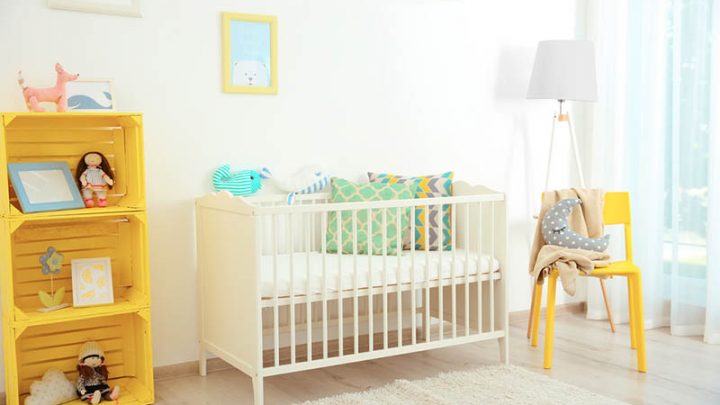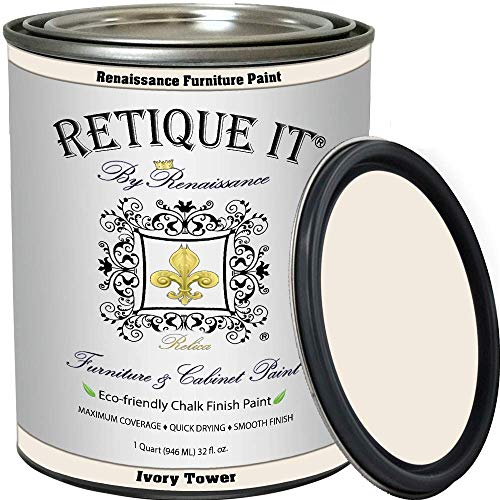Painting the nursery is an important rite of passage for all new parents, but you’re probably thinking about the potential toxicity of the average paint supplies and wondering which ones you should choose.
Thankfully, there are baby safe paints that are nowhere near as toxic as regular paints, which usually contain volatile organic compounds that are emitted into the air and pose a health hazard to you and your baby.
Many pregnant women also wonder if it’s safe for them to paint their baby’s nursery or crib.
The safest option here is to avoid it as there are no household paints on the market that are specifically made with pregnant women in mind.
If you must do it on your own, however, then you’ll definitely need to follow some safety tips like wearing protective clothing (including a mask) and making sure the room is well ventilated.
Most importantly, only use zero-VOC paints.
I’ve put together a short list of baby safe paints to consider for your baby’s room or any other home renovation projects you might consider during your pregnancy!
Just remember to take it easy and ask family and friends to help you out.
6 Non-Toxic Paint Options For Cribs And Nurseries
1. Retique It Chalk Furniture Paint by Renaissance DIY
- Superior coverage - Usually 1 to 2 coats!
- No sanding or priming required
- Non-toxic, zero VOC’s, Safe to use indoors.
- Specifically designed for furniture and cabinets.
Prices pulled from the Amazon Product Advertising API on:
Product prices and availability are accurate as of the date/time indicated and are subject to change. Any price and availability information displayed on [relevant Amazon Site(s), as applicable] at the time of purchase will apply to the purchase of this product.
Let’s say you just got a brand new crib for your baby, and after setting it up in the nursery, you realize that you’re not too crazy about the color, so you decide to paint it.
In this case, one of the best baby safe paint choices would be Renaissance DIY’s furniture paint!
It’s available in so many different colors and it doesn’t require any sanding before applying the new paint.
Best of all, this is a zero-VOC paint, meaning that it won’t emit any harmful chemicals so there’s no need to worry even if your baby decides to chew on the crib.
Plus, it doesn’t smell.
The paint has excellent coverage and you’ll likely only need 2 coats to get the perfect finish. It dries super fast so your furniture will be ready in no time!
2. BEHR Premium Plus Interior Paint and Primer in One
- Brand: BEHR
- Color: White
- Paint Type: Enamel
Prices pulled from the Amazon Product Advertising API on:
Product prices and availability are accurate as of the date/time indicated and are subject to change. Any price and availability information displayed on [relevant Amazon Site(s), as applicable] at the time of purchase will apply to the purchase of this product.
The most important thing to know about the BEHR Premium Plus paint is that it’s Greenguard Gold Certified.
What this means is that the paint was tested for more than 10,000 chemicals, so when the company says their paint has no VOCs, you can rest assured they’re telling the truth!
In addition to giving you peace of mind when it comes to VOCs, this interior paint doesn’t have a heavy odor either.
3. Amy Howard Home One-Step Paint
- Paint without stripping, sanding, or priming!
- Use on surfaces such as wood, glass, fabric, resin, melamine, Formica, concrete, iron, stone, and even outdoor furniture and décor.
- Excellent coverage, adhesion and easy application.
Prices pulled from the Amazon Product Advertising API on:
Product prices and availability are accurate as of the date/time indicated and are subject to change. Any price and availability information displayed on [relevant Amazon Site(s), as applicable] at the time of purchase will apply to the purchase of this product.
The Amy Howard paint is another excellent choice for painting furniture.
It has no VOCs and doesn’t smell bad, so you won’t need to air your furniture out for days to get the smell out.
The color applies well and dries in around 20 minutes, saving you plenty of time.
4. Prestige Interior Paint and Primer in One
- Ultra premium paint and primer in one
- Ideal for living rooms, family rooms, media rooms, bedrooms, dining rooms and hallways
- Low VOC: less than 5 g/l prior to tint
Prices pulled from the Amazon Product Advertising API on:
Product prices and availability are accurate as of the date/time indicated and are subject to change. Any price and availability information displayed on [relevant Amazon Site(s), as applicable] at the time of purchase will apply to the purchase of this product.
The low-VOC Prestige Interior paint and primer is available in different paint colors, although most of them are shades of grey. Still, this is perfect for a gender-neutral nursery!
You can get it in four different finishes: eggshell, flat, semi-gloss, and satin.
Apart from being low-VOC, this paint is free from toxic fumes and reproductive toxins.
5. Country Chic Paint
- Formulated specifically for furniture & home decor; can be used for craft and art projects as well.
- Contains built in primer & top coat. Waxing after painting is optional.
- Dries within 30 minutes to a chalky matte finish that is easy to distress (if desired), yet very durable.
Prices pulled from the Amazon Product Advertising API on:
Product prices and availability are accurate as of the date/time indicated and are subject to change. Any price and availability information displayed on [relevant Amazon Site(s), as applicable] at the time of purchase will apply to the purchase of this product.
If you love bright, fun colors, then the Country Chic Paint is a great option for all your furniture painting needs.
The paint is low-VOC and so are the pigments. It’s also free from the following chemicals:
• Formaldehyde
• Solvents
• Phthalates
• Heavy metals
What’s more, it doesn’t have a foul odor!
You can use it to paint the crib, cabinets, tables… let your imagination run wild!
6. Old Fashioned Milk Paint
- Non-VOC
- Mix Powder with Water (Sizes Match Amount of Finished Paint Product)
Prices pulled from the Amazon Product Advertising API on:
Product prices and availability are accurate as of the date/time indicated and are subject to change. Any price and availability information displayed on [relevant Amazon Site(s), as applicable] at the time of purchase will apply to the purchase of this product.
Milk paint is one of the safest options for pregnant women. In addition to being free from VOCs, milk paint is made from natural ingredients.
It comes in powder form that you need to mix with water before applying to the crib or another wooden surface.
Have fun picking from more than a dozen different colors!
Baby Safe Paint FAQs
Whether you’re planning on buying furniture paint or wall paint, here is some helpful information to keep in mind before purchasing and starting the painting process.
Can I paint the nursery while I’m pregnant?
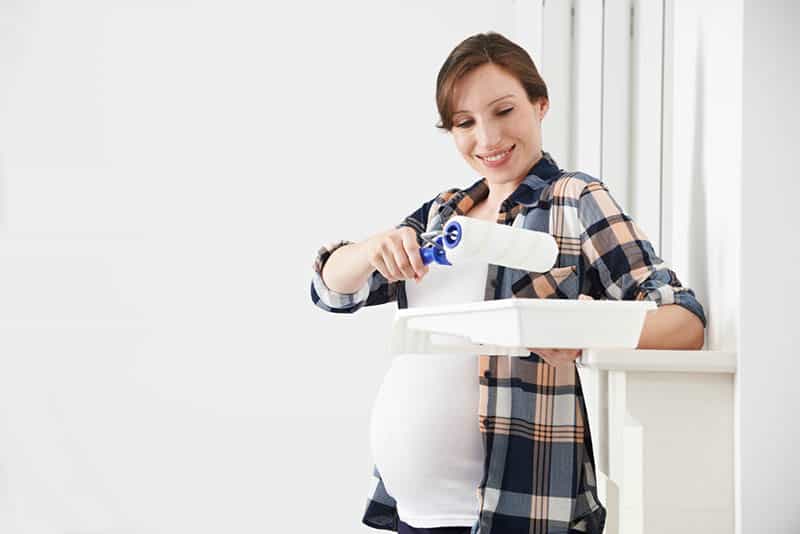
I’m sure you’re eager to take part in the process of decorating the nursery!
From the crib to the glider, everything has to look just right for your little one’s arrival.
But as you know, paint emits fumes, so is inhaling them going to be dangerous for you and your baby?
The answer is complex.
If you want to be 100 percent safe, it’s best to ask your partner, a friend, or a family member to paint it for you.
Or you can just hire a painting contractor to do it!
Now is the time to rest, especially if you’re nearing the end of your pregnancy.
That said, the American Pregnancy Association notes that there is no research regarding the effects of household paint during pregnancy – more specifically, on the baby.
However, it is assumed that the paint used for household projects has low exposure levels.
If you absolutely must paint the nursery on your own, then you should take the following steps to protect yourself:
• Keep the windows open.
• Don’t spend too much time painting without taking a break.
• Put on protective clothing.
• Wear a mask.
The one thing you should not do is remove old paint, especially if the room was painted by the previous homeowner and you have no idea what kind of paint they used.
This puts you at risk of coming into contact with lead-based paint, which was commonly used before the 1970s.
What is the safest paint to use?
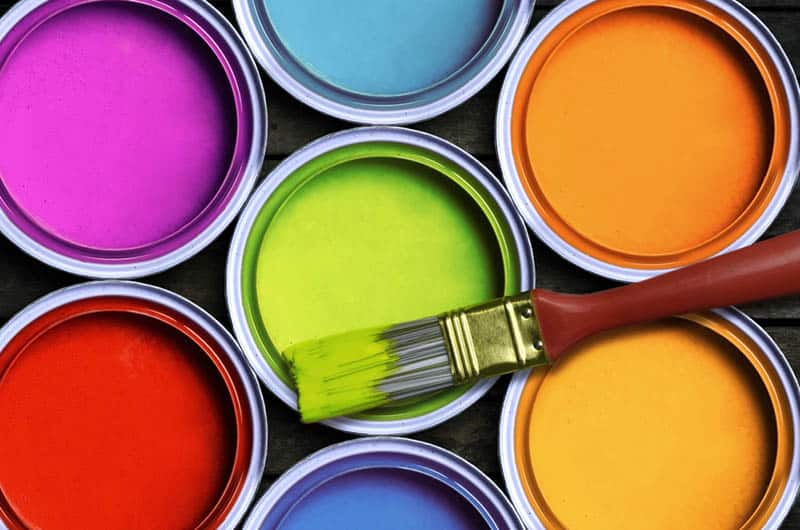
The safest paint to use for your baby’s nursery is zero-VOC.
This stands for zero volatile organic compounds, which are chemicals emitted as gases that can have various negative effects on your health.
VOCs are not only emitted by paint but also by cleaning products, varnishes, certain markers, glues, etc.
Exposure to these chemicals can cause irritation to your throat, eyes, and nose, as well as dizziness and headaches.
That’s why you should always go for zero-VOC emission paints!
Another safe option to consider is milk paint, which is made from natural ingredients and is eco-friendly.
A potential downside is the higher cost but this will also depend on how much of it you need and what you’re planning on painting.
When it comes to latex or acrylic paint, make sure it’s labeled as having low or no VOCs otherwise it could still contain certain chemicals that are bad for you.
You should check the ingredients list and steer clear of the following:
• Ethers
• Ethylene glycol
• Biocides
Lastly, you should avoid oil-based paint.
It usually contains toxic solvents that pose a health hazard.
Toddler And Baby Safe Paint For Crafts
Although painting the nursery or the crib can be lots of fun, especially if you’re really into home improvement, let’s not forget our little ones and letting them have some fun with baby safe paint!
Of course, I’m talking about arts and crafts here, not giving your 12-month-old a paintbrush and letting him loose on your walls!
Unless, of course, you want your walls to look like a Jackson Pollock painting…
Here are a few super easy ideas you can try as a fun activity on a rainy day or whenever your kids feel like doing an art project!
Edible finger paint
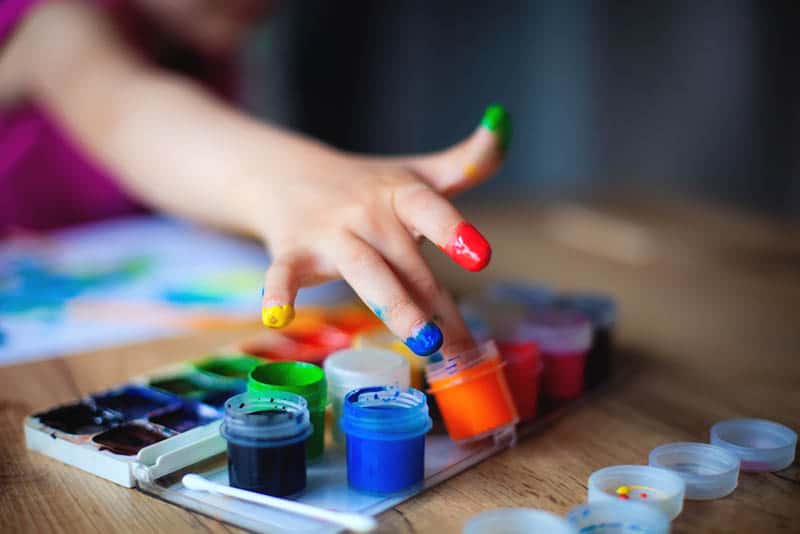
The best part about edible finger paint is that it’s totally safe, even if some of it ends up in your baby’s mouth!
Although “edible” doesn’t exactly mean you should eat it, it’s good to know that the paint won’t harm your baby.
What’s more, homemade finger paint recipes are really easy to follow – you probably already have all the ingredients at home!
Here’s what you’ll need:
• A cup of water (preferably warm)
• Different food coloring
• A cup of white flour
First, mix the water and flour until you get a smooth consistency.
I recommended warm water because it blends better with flour, especially if one of your kids is doing the mixing and not you.
Then, pour the mixture into smaller-sized plastic containers.
If you have five different food colorings, for example, you’re going to need five containers.
After adding the colors, mix again, and let the kids have fun!
If you have older kids, you might want to show them how to create new colors by mixing two together, such as red and blue.
They’ll really enjoy it!
With young children, you’ll want to create a space where they can paint freely and make a mess without damaging anything.
A waterproof playmat that can be wiped clean is a good idea, and so is a high chair.
Homemade watercolor paints
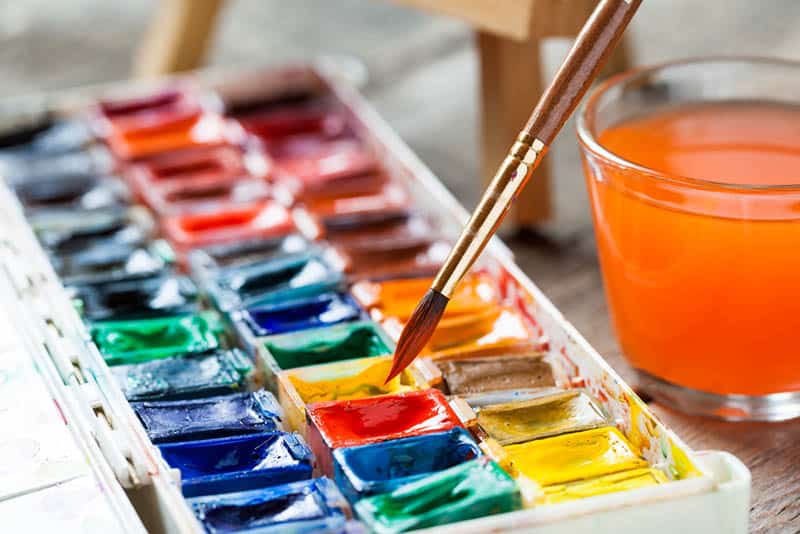
Painting with watercolors was one of my favorite activities growing up – there’s something so magical about the way the colors interact with the water, and your kids can make some truly beautiful artwork!
Of course, you can make watercolor paints at home.
And it’s so easy.
You’ll need:
• Food coloring
• A cupcake pan
• Half a teaspoon of light corn syrup
• Two tablespoons of white vinegar
• Two tablespoons of cornstarch
• Four tablespoons of baking soda
Pour the vinegar and the baking soda into a bowl and stir together.
Then, mix in the cornstarch and the corn syrup.
Keep mixing as you slowly start to pour it into the cupcake pan. Once you’ve distributed the mixture, you can add the food coloring.
Before your little artists get to painting, your homemade watercolors will need to dry fully.
This might take some time, so I recommend making them in the evening and leaving them out to dry overnight.
This is a great activity to do with preschoolers since they’re old enough to hold a paintbrush and really practice their painting skills.
Sidewalk chalk paint
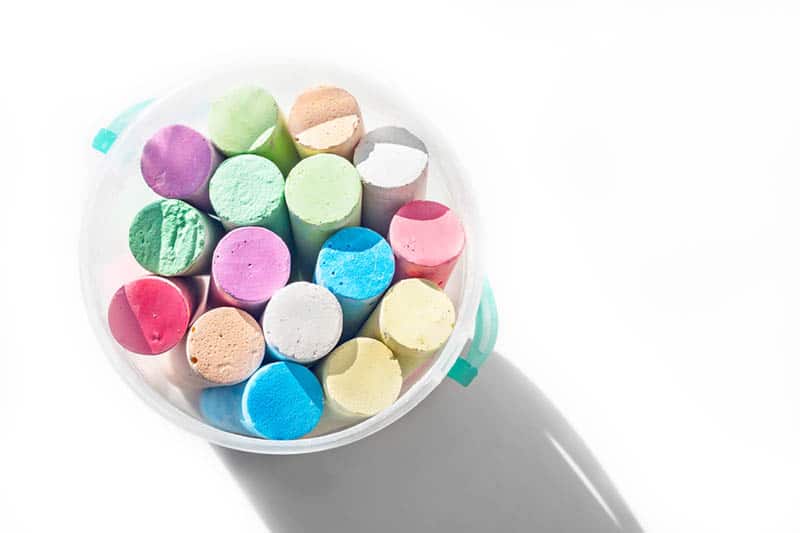
Here’s a fun summer activity for preschoolers and toddlers.
Chalk paint is so easy to make (it doesn’t require actual chalk!) and is ready within minutes.
You’ll need the following ingredients:
• Food coloring
• One cup of cornstarch
• One cup of water
Mix water and cornstarch in a bowl before separating the mixture into individual, smaller containers.
Add the food coloring and mix until you get really pretty colors.
It’s best to use sidewalk chalk paint with brushes but no one is stopping you from finger painting either!
The Bottom Line
When the nesting instinct kicks in, all of a sudden you have all the energy in the world to decorate, reorganize, and remodel!
But before you start sticking those decals to the walls of your nursery, you might want to repaint it first.
Whether you’re looking for a gender-neutral color or something more traditional, the good news is that you can find baby safe paint in these shades.
It should be zero VOC, so you’re not breathing in any toxic fumes.
Make sure to pick a brand that’s easy to apply and dries quickly – this will make the entire process quicker and safer.
The paint shouldn’t have a strong odor either.
That said, I suggest enlisting the help of friends and family when it comes to repainting the nursery or even your baby’s crib.
Regardless of how far along in your pregnancy you are, you deserve to rest, and I’m sure there are people who would love to be a part of your nesting journey!
I hope you found my suggestions helpful – I just know you’re going to have the most beautiful nursery ever!
• References:
American Pregnancy Association. (2012, May 1). Painting While Pregnant. American Pregnancy Association website.
Like this post? Please share or pin it for later. You can also stay in the loop and follow us on Facebook, Instagram or Pinterest.
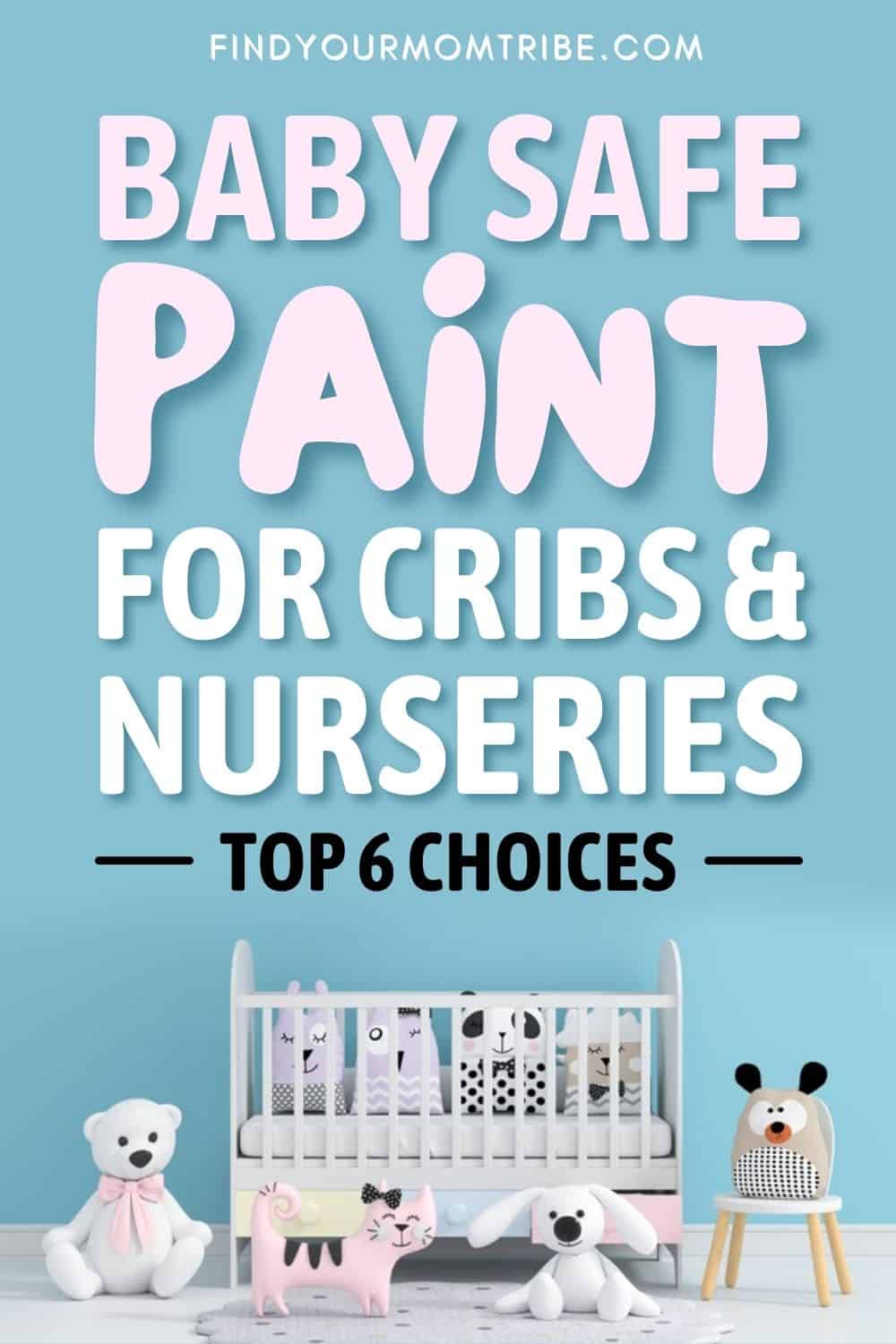
We love honesty! Find Your Mom Tribe is an Amazon Associate and we earn from qualifying purchases through affiliate links at no extra cost to you. Please see our full Amazon Affiliate disclosure for more information.

